Contents
Did you know 90% of the hair on your scalp is growing at any time? This fact shows how our hair is always in a cycle of growth and renewal. Knowing this normal hair growth cycle is key to keeping your hair healthy and tackling hair loss.
The hair growth cycle has four stages: anagen, catagen, telogen, and exogen. Each stage is part of a cycle that keeps your hair looking full and vibrant. But, this cycle can cause hair loss if it gets disrupted.
For those dealing with thinning or excessive shedding, understanding the hair cycle is crucial. It explains why some treatments work and others don’t. It also helps us see why some people have perfect hair while others struggle with loss.
Exploring each stage of hair growth gives us insights into how our hair works. It tells us how to support its health. Whether you want to boost growth, reduce shedding, or keep your hair looking great, knowing the hair cycle is the first step.
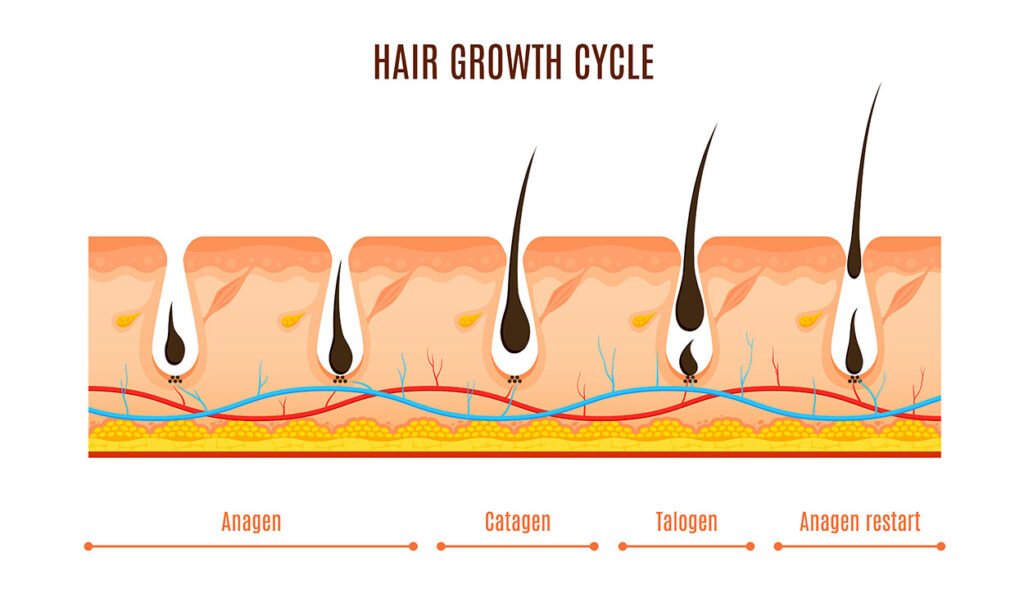
Key Points in This Article
- 90% of hair is in the active growth phase at any time
- The hair growth cycle consists of four stages: anagen, catagen, telogen, and exogen
- Understanding the hair cycle is crucial for addressing hair loss issues
- Each hair follicle goes through the growth cycle independently
- Disruptions in the hair growth cycle can lead to thinning and excessive shedding
- Knowledge of the hair cycle can help in choosing effective hair care strategies
Introduction to Hair Growth and Its Importance
Hair is crucial for your health and looks. Knowing how hair grows and its parts is important for keeping your hair healthy. Your body has about five million hair follicles. They protect you from cold and UV radiation.
The Significance of Healthy Hair
Healthy hair shows how well you’re doing overall and boosts your confidence. Hair follicles make sebum to keep your scalp moisturized. You lose 50 to 100 hairs every day as part of the natural cycle.
Overview of the Hair Growth Process
The hair growth cycle has four stages: anagen, catagen, telogen, and exogen. Each stage is vital for hair health. The anagen phase, where hair grows, lasts 3-5 years for scalp hair. Hair grows about 0.35 mm daily or 1 cm a month during this time.
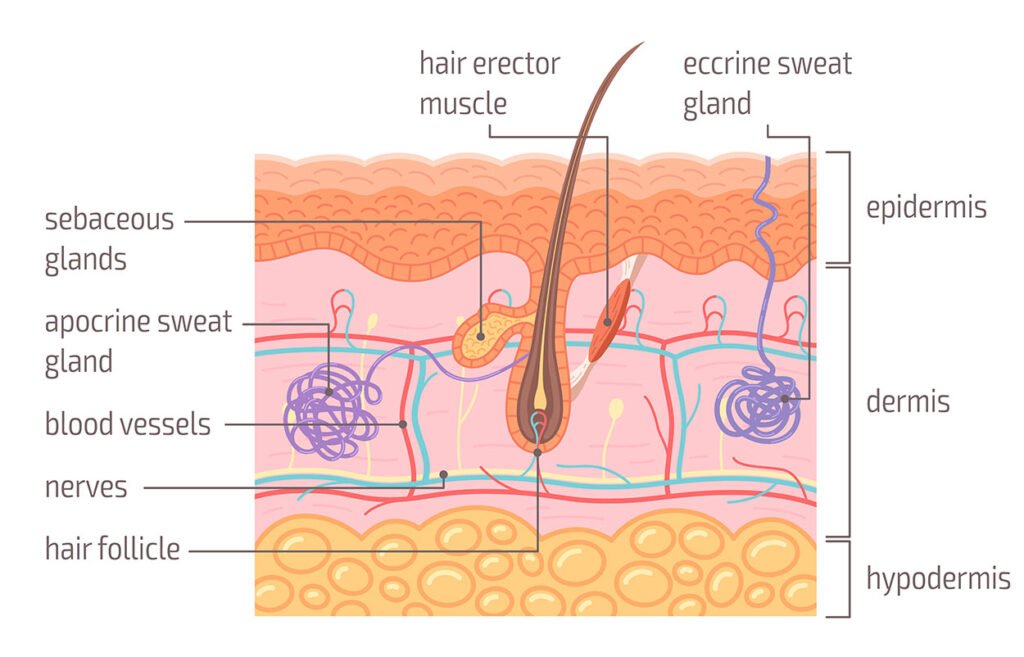
Factors Affecting Hair Growth
Many things affect how your hair grows and stays healthy. Your genes decide your hair type and how it grows. Eating right is key, with vitamins D, C, iron, zinc, and B12 helping your hair grow well. Stress can mess with the hair growth cycle, causing conditions like telogen effluvium.
| Hair Growth Phase | Duration | Percentage of Hair |
|---|---|---|
| Anagen (Growth) | 3-5 years | 90% |
| Catagen (Transition) | 10 days | 5% |
| Telogen (Resting) | 3 months | 10-15% |
| Exogen (Shedding) | 2-5 months | Varies |
The Normal Hair Growth Cycle Explained
Your hair goes through a fascinating journey of growth and renewal. This process, known as the hair growth cycle, has four stages. These stages shape the life of each hair on your head. Knowing about these phases can help you take better care of your hair and deal with hair loss.

The cycle starts with the anagen phase, the active growth stage. Your hair grows about 1-1.5cm per month, especially in summer. This phase lasts 3 to 5 years for most people, but can be up to 7 years for those with Asian hair. It makes up about 90% of the cycle, lasting over 1000 days.
Then comes the catagen phase, a short transition lasting 1-2 weeks. This is followed by the telogen phase, where your hair rests for 3 to 4 months. Finally, the exogen phase occurs, where old hairs are shed to make room for new growth.
A hair follicle diagram shows these stages clearly. Each follicle works on its own, ensuring you always have hair in different growth stages.
- Anagen (growth): 3-5 years
- Catagen (transition): 1-2 weeks
- Telogen (rest): 3-4 months
- Exogen (shedding): Occurs during new anagen phase
Things like stress, diet, and health issues can affect this cycle. For example, intense dieting or high stress can cause hair loss about 6 weeks later. By understanding these four stages and their timelines, you can take better care of your hair and talk to your healthcare provider about any concerns.
Anagen Phase: The Active Growth Stage
The anagen phase is the key time in your hair’s life cycle. It’s when your hair shaft grows new hair, making your look better.
Duration and Characteristics
This phase can last from 2 to 6 years for scalp hair. About 90% of your hairs are growing at any time. Some people’s hair can grow very long because of longer anagen phases. Others might see shorter growth due to their genes.
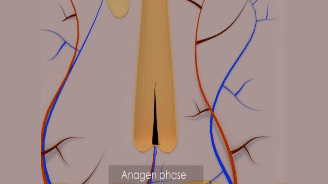
Influencing Factors
Many things can change how long the anagen phase lasts:
- Genetics
- Age
- Nutrition
- Stress levels
- Hormonal changes
Importance for Hair Health
The anagen phase is crucial for healthy hair. Longer phases mean fuller, longer hair. But, issues like anagen effluvium can stop this phase, causing hair loss. Some products aim to boost and extend the anagen phase, helping with hair growth and thickness.
| Anagen Phase Characteristic | Description |
|---|---|
| Duration | 2-6 years for scalp hair |
| Percentage of Hair | 90% of scalp hair |
| Growth Rate | Approximately 0.5 inches per month |
| Influencing Factors | Genetics, age, nutrition, stress, hormones |
Catagen Phase: The Transition Period
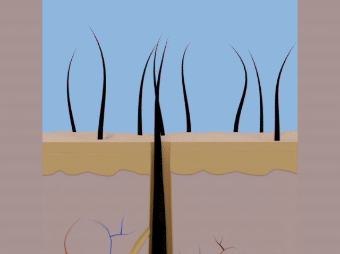
The catagen phase is a key step in your hair’s life cycle. It lasts about two to three weeks, signaling the end of growth. Your hair follicles change a lot, getting ready for the resting phase.
During this phase, your hair follicle shrinks. The lower part of the follicle pulls away from the blood supply. Yet, your hair stays in place, held by the upper part of the follicle.
About 5% of your scalp hairs are in the catagen phase at any time. This phase is crucial for keeping your hair growth cycle healthy. It helps your body recycle nutrients and get ready for new hair growth.
| Phase | Duration | % of Scalp Hair |
|---|---|---|
| Anagen | 2-7 years | 90% |
| Catagen | 2-3 weeks | 5% |
| Telogen | 3 months | 10-15% |
Knowing about the catagen phase helps you take better care of your hair. This short but important phase is part of your hair’s natural cycle. By living a healthy life and taking good care of your hair, you support it through every growth phase.
Telogen Phase: The Resting Stage
The telogen phase is a key part of your hair’s life cycle. It lasts 3 to 6 months, where your hair follicles pause from growing. This break is essential for your hair to rest before it starts growing again.
Length and Features of the Telogen Phase
About 10% to 15% of your scalp hairs are resting during the telogen phase. They don’t grow, but they don’t fall out either. This time lets your follicles prepare for a new growth cycle.
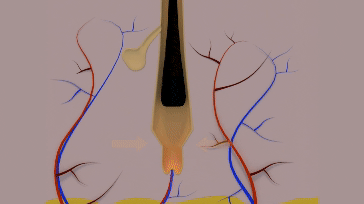
Telogen Effluvium and Its Causes
Telogen effluvium makes more hairs than usual enter the resting phase, causing a lot of hair loss. This can happen due to:
- Childbirth
- High fever
- Sudden weight loss
- Surgery
- Severe illness
- Emotional stress
Normal vs. Excessive Hair Shedding
It’s normal to lose 50 to 100 hairs every day. Losing more than this is considered excessive. If you see a lot of thinning or bald spots, see a dermatologist for help.
| Characteristic | Normal Hair Shedding | Excessive Hair Shedding |
|---|---|---|
| Daily Hair Loss | 50-100 hairs | Over 100 hairs |
| Duration | Consistent | Prolonged (over 6 months) |
| Appearance | No visible thinning | Noticeable thinning or bald spots |
Knowing about the telogen phase helps you take better care of your hair. It also tells you when to get professional help for hair loss issues.
Exogen Phase: The Shedding Stage
The exogen phase is the last stage of hair growth. Here, you’ll see hair fall as old hair is replaced by new. This process is key for keeping your hair and scalp healthy.
This shedding phase lasts 2 to 5 months and is normal. You might lose 50 to 100 hairs every day. This loss is part of your body’s way of renewing itself. It’s important to remember that your scalp is always cycling through growth and shedding.
It’s important to know the difference between normal hair loss and too much shedding. Losing up to 100 hairs a day is okay. But losing more could mean there’s a problem. For example, telogen effluvium can cause up to 300 strands to fall out daily.
| Hair Growth Phase | Duration | Percentage of Hair |
|---|---|---|
| Anagen (Growth) | 2-7 years | 90% |
| Catagen (Transition) | 2-3 weeks | 5% |
| Telogen (Resting) | 3-6 months | 10-15% |
| Exogen (Shedding) | 2-5 months | Varies |
To keep your hair healthy during the exogen phase, eat a balanced diet full of protein, iron, and vitamins. Also, take good care of your scalp and handle your hair gently. This helps your hair go through all growth stages smoothly.
Common Hair Loss Issues and Their Relation to the Growth Cycle
Hair loss is a big problem for many Americans. It disrupts the normal way hair grows. Knowing about these issues can help you spot and fix problems early.
Androgenetic Alopecia: Male and Female Pattern Baldness
Androgenetic alopecia, or pattern hair loss, is the most common type of hair loss. It hits over 50 million men and 30 million women in the U.S. Men often start losing hair in their teens or early twenties. Women usually notice it after 40. You can find more about the mechanism by which the Di-Hydro-Testosterone hormone – DHT is linked with Alopecia.
Alopecia Areata and Autoimmune Hair Loss
Alopecia areata is an autoimmune condition that leads to patchy hair loss. It can happen to adults and kids, with most people seeing hair grow back in a few years. But in some cases, it can turn into alopecia universalis, making someone lose all their body hair.
Stress-Induced Hair Loss
Stress can cause hair loss, known as telogen effluvium. This makes 300 to 500 hairs fall out every day. Stress also can lead to trichotillomania, a condition where people pull their hair out.
| Hair Loss Type | Affected Population | Characteristic |
|---|---|---|
| Androgenetic Alopecia | 50+ million men, 30+ million women | Pattern baldness |
| Alopecia Areata | Adults and children | Patchy hair loss |
| Telogen Effluvium | Varies | 300-500 hairs shed daily |
Knowing about these common hair loss issues and how they affect the hair growth cycle helps you keep your hair healthy. It also helps you find the right treatment when you need it.
Solutions and Treatments for Hair Loss
Dealing with hair loss can be tough, but there are many effective treatments out there. Understanding your options and taking action is the first step to promote healthy hair growth.
Minoxidil is a popular choice for many types of hair loss. It’s a topical solution that may take four months to a year to show results. For men, oral finasteride is another option that starts working after about four months.
Women with pattern baldness might find antiandrogens like spironolactone helpful. These medications start working around the four-month mark but need to be used long-term for best results.
Good hair care is key in managing hair loss. Be gentle with your hair, avoid harsh chemicals, and use the right products. Eating a balanced diet full of proteins, vitamins, and minerals also supports hair growth from the inside out.
| Treatment | Time to See Results | Best For |
|---|---|---|
| Minoxidil | 4 months – 1 year | Various types of hair loss |
| Finasteride | 4 months – 1 year | Male pattern baldness |
| Antiandrogens | Around 4 months | Female pattern baldness |
| Corticosteroids | 1-2 months | Autoimmune-related hair loss |
Consistency is crucial with hair loss treatments. Stick with your chosen method and be patient. For the best results, talk to a dermatologist. They might suggest a mix of treatments that fit your needs.
Animated Video on Hair Growth Cycle
Please watch this vide below explaining normal hair growth cycle in animation video:
FAQs
Q: What is the hair growth cycle and its stages?
A: The hair growth cycle consists of four distinct stages: anagen (growth), catagen (transition), telogen (resting), and exogen (shedding). Each stage of the hair cycle plays a crucial role in the overall process of hair growth.
Q: What happens during the anagen phase of the hair growth cycle?
A: During the anagen phase, human hair undergoes active growth. This phase can last several years and is when the hair bulb is actively producing new cells, leading to increased hair length.
Q: How does the catagen phase function in the hair growth cycle?
A: The catagen phase is a short transition phase that lasts a few weeks. During this phase, the hair follicle shrinks, and growth factors like insulin-like growth factor and fibroblast growth factor decrease, signaling the end of active growth.
Q: What is the significance of the telogen phase in hair growth?
A: The telogen phase is the resting phase of the hair cycle. In this phase, the hair follicle is inactive, and the hair strand remains in place until it is naturally shed to make way for new hair growth.
Q: How does the exogen phase differ from the other phases of hair growth?
A: The exogen phase is the shedding phase where telogen hair falls out. This is a normal part of the hair growth cycle and allows for new hair to grow in its place.
Q: What causes hair thinning and loss of hair?
A: Hair thinning and loss of hair can be caused by various factors, including genetics, hormonal imbalances, nutritional deficiencies, and stress. Conditions like female pattern hair loss and premature hair loss can also contribute to these issues.
Q: How can understanding the anatomy and physiology of hair help in hair care?
A: Understanding the anatomy and physiology of hair, including the structure of the hair bulb and the phases of hair growth, helps in developing effective hair care routines and treatments to maintain healthy, growing hair.
Q: What role does the normal hair follicle play in the hair growth cycle?
A: The normal hair follicle is essential in the process of hair growth, as it houses the hair bulb and supports the various stages of the hair growth cycle. Proper follicle function ensures the continuous regeneration of hair.
Q: How long does each stage of the hair growth cycle last?
A: The duration of each stage of the hair growth cycle varies: the anagen phase can last 2-7 years, the catagen phase lasts about 2-3 weeks, the telogen phase lasts around 3 months, and the exogen phase involves the shedding of hair which can happen throughout the year.
Q: Can new hair grow after experiencing permanent hair loss?
A: Permanent hair loss means that the hair follicles are no longer capable of producing new hair. However, treatments like hair transplants and certain medications may help stimulate hair follicle growth and promote new hair growth in some cases.
Conclusion
Understanding how hair grows is key to keeping it healthy and preventing loss. Hair goes through different phases, each important for its health. The anagen phase, where hair grows about 0.5 to 1.7 cm a month, lasts around 3 years for scalp hair, sometimes up to 5 years.
The catagen phase is short, affecting 3% to 5% of hairs at a time, slowing growth. Then comes the telogen phase, with 10% to 15% of your hair strands for about 3 months. Finally, the exogen phase sheds 50 to 100 hairs daily. This cycle keeps going, with about 67-70% of hair in the telogen stage and 2-3% in catagen at any time.
Knowing these phases helps you keep an eye on your hair’s health and prevent loss. Regular care, acting early, and getting professional advice when needed can keep your hair healthy all your life.
